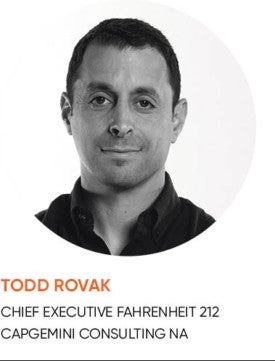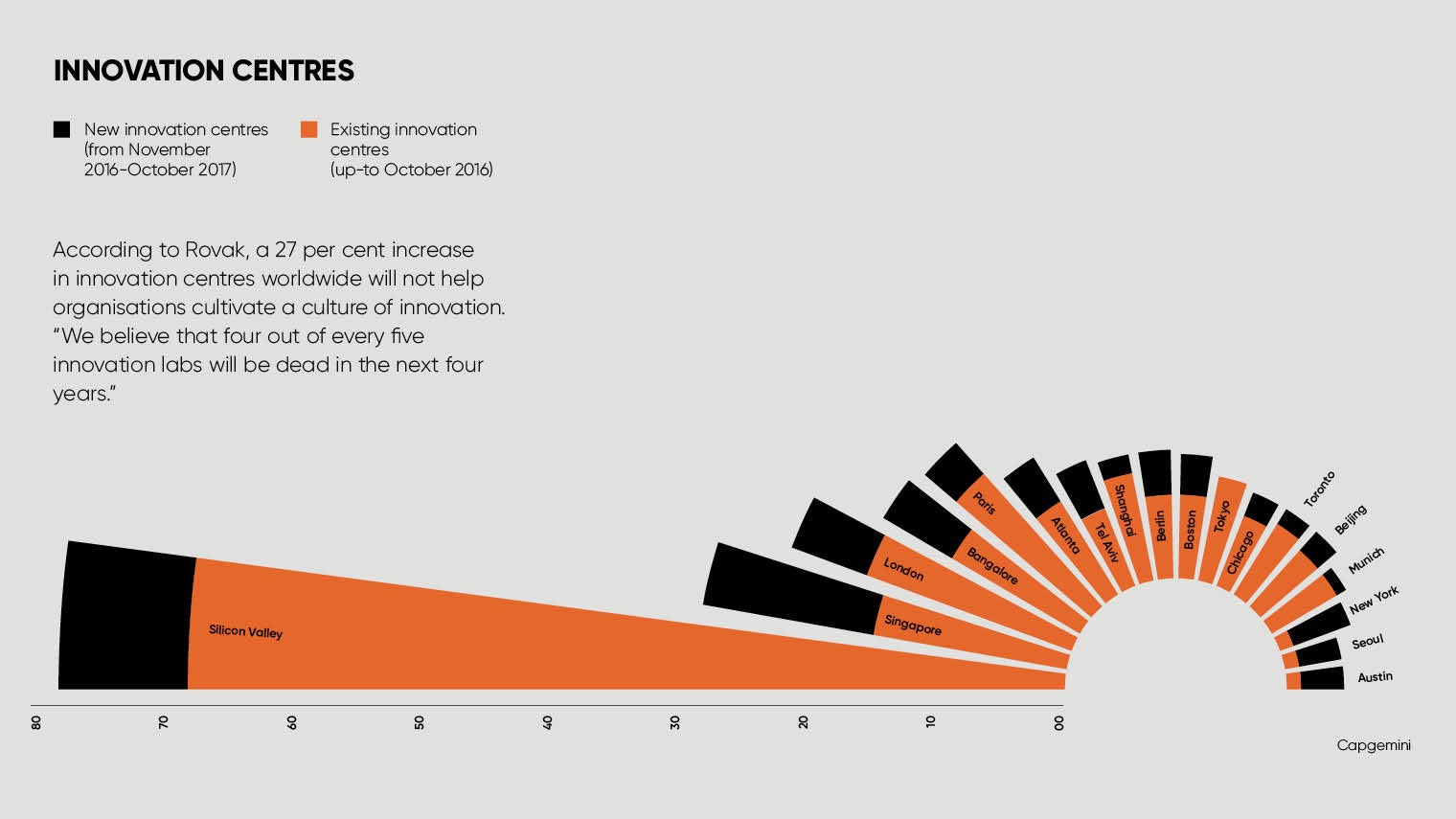 Todd Rovak, the Brooklyn-based chief executive of innovation and design consulting firm Fahrenheit 212, used by industry titans such as Coca-Cola, Samsung and IKEA, is extremely well placed to offer his opinion on innovation.
Todd Rovak, the Brooklyn-based chief executive of innovation and design consulting firm Fahrenheit 212, used by industry titans such as Coca-Cola, Samsung and IKEA, is extremely well placed to offer his opinion on innovation.
Fahrenheit 212 joined Capgemini in 2016 and is considered to be a thought leader and pioneer in innovation. Visit Fahrenheit 212’s website and the first thing you will see is the mantra: “Innovation is the engine of progress. We live for the pursuit of the next.”
It is high time, demands Mr Rovak, to refocus and sharpen the business definition of innovation on both sides of the Atlantic, and to “poke holes in some of the language used”. For him, chief executives with an eye on the future and armed with a growth mindset simply have to be thinking about this subject obsessively. Hitherto many of them have been wasting their time and money, from his perspective.

“There seems to be an obsession with startups and disruption,” the 39-year-old Harvard Business School MBA graduate begins. “Those are not helpful words because there could be a massive set of changes and products that will trigger huge creation – the origination of new value, which is what we are looking for – without technically needing to disrupt every time.
“While disruption is sometimes the outcome of innovation, it should not be the goal. Successful innovation hits the intersection between being creative and useful. It is not enough to advance this cultural willingness to move forward because of some disruptive startups.”

Mr Rovak says there are two traditional schools of thought around business innovation: “the playground approach” and “optimisation”. Both are wrong, he argues.
“The first one centres on randomness, Post-it notes, workshops, and the belief that creativity and design is the answer to everything,” he explains. “It is undisciplined, and what you end up with is a whiteboard full of ideas, most of which are both unimplementable and not accredited to the business.
“In essence what you produce is an interesting two-day exercise, or a beautifully designed PowerPoint or video which ultimately ends up in a drawer. As such, I predict that four out of every five innovation labs will be dead in the next four years.”
Mr Rovak is even more damning of the “insidious” second approach. “Optimisation posits that slowly moving forward, and taking cost out to be more efficient and sustaining innovation is enough. The entire management-consulting industry was built around optimisation or being better at what you already do,” he says.
“The problem about this optimisation cycle, which is fed by the management-consulting industry, frankly, is that while it creates an incremental new value, it doesn’t make anything that drastically shifts the needle. That is because meaningful new business models, customer experiences and products are not created by advancing what you already have.
“You can only pursue growth, profitability and market returns through efficiency for so long, and many CEOs are finding they have effectively wrung out as much of that as they can. That is why they are now looking to innovation, through new products, services and experiences, to be a growth driver and boost the top line.”
They require an innovation strategy that enables them to have an origination ecosystem
So what should progressive CEOs do? “They require an innovation strategy that enables them to have an origination ecosystem,” Mr Rovak says. “The origination ecosystem behaves differently to the optimisation ecosystem. The former allows you to kill projects that don’t deserve to live and also means you can bring in a lot of different talents, much like an orchestra conductor, to develop a complex idea. It’s more than just having a fun workshop. It has different rules, structures and behaviours that we need to acknowledge and embrace if we are truly going to have a successful innovation ecosystem.”
He says one of his favourite quotations about innovation was spoken by Saturday Night Live producer Lorne Michaels. Mr Rovak says: “Lorne was asked: ‘Do you ever feel totally constrained by the live television format?’ And he replied: ‘There is no creativity without constraint.’
“You need guidelines. Innovation strategy serves a purpose to focus the organisation. It’s imperative to put targets on the wall for people’s creativity and reward it accordingly.”
Further, the CEO has to take the lead when steering this and to create an organic culture, which oozes structured innovation and means actions are much louder than words. “Innovation comes from all over and therefore needs to involve the whole company, but it certainly has to start from the top down,” he insists.
“A culture of innovation is not created by having cool furniture, beanbag chairs, a smoothie station or an interesting laboratory. You can’t just flip a switch and keep yelling ‘culture’ at people. Culture is created by what is rewarded and what is strategic to the company.
“The CEO needs to create an innovation strategy that the company can own. It’s not enough to say ‘let’s innovate’ and hope that it will happen by magic. Ideas are easy to come up with; good ideas are hard. To obtain useable, worthwhile ideas there needs to be a framed innovation strategy, as defined by the CEO.
“It has to be something that is defensible, ‘ownable’ and can leverage the company’s assets. It’s not a wish, a mandate or a call to action. It says: ‘We are going to win this space by leveraging x assets, over this timeline.’ Most importantly, it must be anchored in a quantifiable commercial outcome.”
Offering a final piece of advice to CEOs, Mr Rovak adds: “Encourage the problem-solving skills that underpin value origination and not value optimisation. Because whether we know it or not the age of origination is here. There will be new players in this world and Fahrenheit 212 is certainly aiming to be a key one. The winners will be those who see what is happening here and structure their origination ecosystem first.”
Explore further at fahrenheit-212.com







